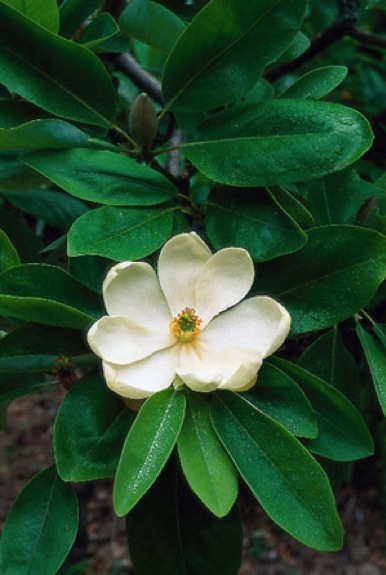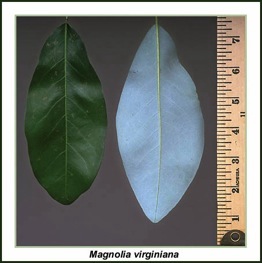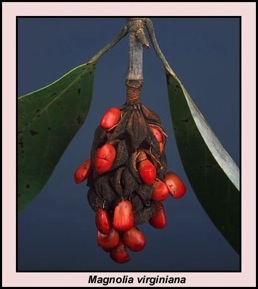
The Sweetbay has large, waxy blossoms
Magnolia viginiana: How Sweet It Is
Let’s say you want or need to trap a beaver. First you need a trap, but then you need to bait the trap. And then the question becomes, what do you bait a beaver trap with? There is an answer: Magnolia virginiana.

The silver is caused by little hairs
Beavers find the fleshy roots of the “Sweet bay” irresistible, a preference that was not missed by early colonists to North America. Beavers aren’t the only ones who find the tree a source of a meal. Deer and cattle like the leaves and twigs. It can be up to 25% of their winter diet. Squirrels, white-footed mice, turkeys, quails and songbirds like its fruit. Humans make a tea from its leaves and use them to flavor soups and stews.
Among those who consider such things the leaves of the M. virginiana are considered slightly inferior to those of the Perseas in flavor, though they are used the same way (to see an article on the Perseas elsewhere on this site click here.) While the Perseas have a more complex flavor profile the Sweetbay appeals more to the nose with a hint of vanilla. It is also a more attractive, larger tree. And the truth be told, the Sweetbay is a whole lot easier to identify than the Perseas. The lance-shaped leaves are a rich green on top and a solid silver on the bottom. When the wind blows, the tree flashes a handsome metallic sheen. That glimmer is caused by minute white hairs on the young leaves, which can be rubbed off.
The aromatic wood is soft, even-grained and very easy to work. Besides trapping beavers, it’s used for veneer, boxes, containers, tool handles, furniture, lumber and plywood. The Sweetbay ranges from Glouster, Massachusetts, to Florida to Texas, though it is most common in South Carolina, Georgia, Florida and Alabama.
Besides the Sweetbay the leaves of the Magnolia grandifolia can be used for seasoning (slightly bitter) and the petals of the blossoms pickled in a vinegar and sugar solution to make a condiment. Interestingly the Magnolias are related to the smaller papaw, but much younger say the botanists.
Two other magnolias are worth mentioning, M. hypoleuca and M. kobus. The young leaves, flower buds of the M. hypoleuca are boiled and eaten as a vegetable. Older leaves are dried then sprinkled on food as a flavoring. Whole dried leaves are filled like small boats with food then grilled. Leaves used that way are not eaten but they impart their flavor to the food cooked in them.
The flowers and buds of the M. kobus are also boiled and eaten. Older leaves are eaten or used to make a tea. The leaves are also dried and powered and used as a seasoning.
As for the scientific name, Magnolia (mag-NO-lee-ah) is named after French botanist Pierre Magnol, 1638-1715, who was the physician of King Louis XIV of France and was the director of a botanical garden at Montpellier and also a professor of Botany at Montpellier. Virginiana (vir-gin-knee-AY-nah) means of North America. Grandifolia means large leaves. Hypoleuca (high-poh-LOO-kuh) is Greek that means “under white.” Kobus (KOE-bus) is the native name for that magnolia.
Green Deane’s “Itemized” Plant Profile
IDENTIFICATION: The Sweetbay Magnolia is a tree to 90 feet, with an open crown of sparse branches. The farther north the smaller the tree. Its leaves are simple, alternating, oval to oblong, four to six inches in length. Its bark is gray-brown, smooth and tight. the thin leathery leaves are smooth and shiny green on top, white below. The fruit is an aggregate that releases many flat. oval, red seeds (not edible.)
TIME OF YEAR: Year round
ENVIRONMENT: It is found in swampy areas, wet soil and along streams and ponds.
METHOD OF PREPARATION: Leaves can be used to make a tea or use like a bay leaf to flavor soups and stews or make a marinade.




I have two types of magnolias, one tall one that has very small yellow flowers on it that produce long brown pods , with they dry have several small red seeds in them. I have a rabbit that eats the seeds? The other one is I believe is a little John Magnolia which has a large white flower. My question is can humans eat them and will the seeds hurt the rabbit?
Any information would be appreciated.
Thank you Sandy
No, humans do not eat the magnolia seeds. About rabbits I do not know.
Good to know. I actually tasted Magnolia seeds a few years back, in Dallas, Texas. They tasted quite good, like cinnamon, however, I spit them out afterwards, b/c I’d never heard of anyone eating them. No ill effects from tasting.
I read the Indians used the seeds by sucking on them, didn’t mention why.
Interesting! Do you recall the source? I’ve been looking for info about the fruits of M. Grandiflora and others too. I think we should differentiate between eating the arils of the fruit (the sweet cinnamony red part) vs crunching the actual seeds. That seems to check out with your note about sucking them. I have also nibbled and spit the fruit and found it delicious and inspiring. I’ve found conflicting sources about edibility though so I’ve not yet actually used it in a recipe. It seems like it could make a great cocktail, or gingerbread, or meat marinade.
thinking about using magnolia seeds in brewing a beer. they smell yummy. can I dry them,crush them, and use them? thanks for any advice
Not that I know of. To my knowledge the seeds are not edible or useable in any way. Why not use a leaf, that can be used for flavoring.
Does anyone know What, if any, are the side effects if you eat the seeds.
Don’t eat the seeds.
Flowers are used in TCM as antitussive, anti-inflammatory and anti-allergic. Great for chronic rhinitis, respiratory troubles, headaches and colds. Overdosage may give dizziness. 3-9 g decocted.
May I have the recipe for candied magnolia flowers, and the leaf for tea. I’d love to try both from the Sweet Bay magnolia.
Greene Dean, Thank you so very much for all the interesting info you put out there about plants. I have come to love them all. You have ignited my passion for them with the in-depth thorough information you share for plants. Especially how they can sometimes be used for medicine etc. so interesting. You truly have been blessed and to share it with others all over the world is amazing this world we live in. The creator is so amazing . I just wanted to say thank you . You are the most trusted source I have about plants . From the island of Oahu, Hawaii, with much Aloha !
To me the coolest fact about the Sweetbay magnolia is that it is the type species for genus Magnolia, which is the type genus for order Magnoliales. Thus Sweetbay magnolia is the type species for all flowering plants, an honour well-deserved.
Dean do you know if Magnolia champaca has any edible parts?
It used to be called Michelia champaca. Cornucopia II says on page 146: “The aromatic, bitter bark is sometimes used to adulterate cinnamon. Fruits are said to be edible.”
My magnolia, in SC, gas large white flowers and the underside of the leaves are coppery colored. Is this considered southern magnolia? Is any of the tree edible?
That is probably Magnolia grandiflora.
I’m trying to figure out how to tell these and the persias apart. I’ve been able to discern some of these by seeing the Magnolia seed pods on them, but I’m not sure if I’ve seen any of the bays or not. Also I think it might kinda of look similar to the laurel cherry (which I’ve heard is poisonous). I don’t think I’ve come across the laurel cherry, I’ve heard it might smell of almonds, so that might help there. Any other pointers, I’ve smelled leaves, its somewhat fragrant but they don’t seem too strong to me and I think I’d have a hard time telling them apart. I think I’ve encountered both growing in a somewhat swampy area by the road in Orlando, but without flowers etc. I’m not sure how to tell the leaves apart.